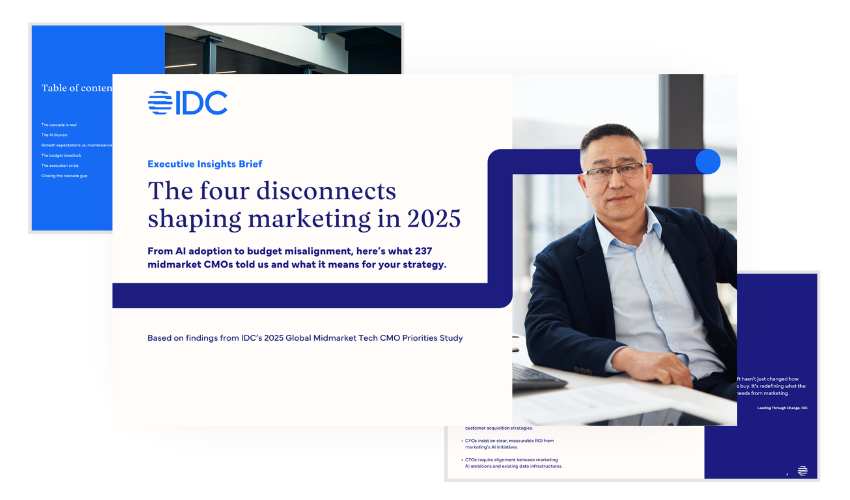On the surface, AI seems woven into modern marketing. Pilot programs are evolving into real workflows. AI tools are being deployed for a variety of tasks. Teams are becoming more fluent in GenAI, automation, and orchestration.
But underneath it all, the foundation is often still rocky. Insufficient infrastructure, skill shortages, and a lack of clear governance reveal a distinct disconnect: many organizations are mistaking adoption for advancement, and it’s creating a false sense of AI maturity.
In fact, just over half of midmarket CMOs have implemented AI or GenAI into their marketing strategy, according to IDC’s 2025 Global Midmarket Tech CMO Priorities Survey. Yet only 26% are seeing improved efficiency, creativity, and effectiveness as a result.
This gap between confidence and capability defines what IDC calls the illusion of AI adoption.
At the same time, CMOs face mounting pressure to deliver more, faster. From bold innovation and customer acquisition to measurable ROI and alignment with enterprise tech infrastructure, today’s marketing leaders are navigating what IDC refers to as the Pressure Cascade: a compounding set of executive expectations with limited room for missteps.
This illusion of AI adoption is just one of four key disconnects reshaping marketing in 2025. And the first step to achieving true AI-driven growth is breaking through the illusion.
Download IDC’s Executive Insights Brief: The four disconnects shaping Marketing in 2025 and get three proven strategies to cut through the illusion of AI readiness and realign your AI ambitions with operational reality. Plus, uncover more insights into the AI challenges facing CMOs today.
The mirage of AI maturity
Momentum can create the illusion maturity. The presence of AI tools, active experimentation, and a handful of successful use cases can have organizations thinking they’ve successfully transformed into optimized, AI-infused operations.
But the reality is that most transformations are still in the early stages.
According to IDC’s MaturityScape: AI-Fueled Organization 1.0, a majority of midmarket businesses are undergoing an opportunistic pivot to AI while working to formalize strategy, establish oversight, and integrate practices across teams.
The problem isn’t that these companies are doing the wrong things. It’s that they’re doing the right things in isolation.
Experimentation remains siloed. Cross-functional learning is limited. AI efforts may be structured, but they’re not yet orchestrated or repeatable.
This pivot phase can generate positive signals such as early productivity gains, promising pilot outcomes, and internal excitement. But those signals can also be misleading. Without a strong foundation in place, organizations can’t move from experimentation to scale.
What emerges is a semblance of progress: a hodgepodge of capabilities that looks advanced but doesn’t have the basis to deliver long-term value.
Understanding where your organization stands on the AI maturity journey is a critical step toward ensuring your efforts in AI aren’t just active, they’re effective. And without that clarity, it’s easy to mistake movement for mastery.
The AI readiness gap: Perception vs. preparedness
While many marketing leaders are confident in their organization’s AI trajectory, IDC’s research reveals a different picture. On paper, AI adoption appears to be surging. However, operationally, most organizations are still grappling with fundamental gaps that limit impact and scalability.
For example, 37% of midmarket CMOs believe AI-enabled marketing technologies have potential to help their organizations over the next 12-18 months, according to the Midmarket survey. This includes incorporating tools and workflows to boost content creation and automate campaigns, critical elements of modern marketing success.
Still, only 31% of the same CMOs are prioritizing the modernization of their MarTech stacks. This is a crucial metric. Without updated systems and integrated data pipelines, even the most sophisticated AI tools remain disconnected from broader workflows, limiting their value.
What emerges is a widening gap between perception and preparedness.
Leaders may feel confident in their AI capabilities, but confidence alone doesn’t modernize platforms, upskill teams, or align cross-functional strategy. Without a clear-eyed look at operational readiness, organizations risk mistaking AI activity for AI advantage. And in doing so, they leave substantial business value untapped.
The blind spots hiding true transformation
The illusion of AI readiness isn’t just about overconfidence: It’s about overlooked fundamentals. Lurking beneath the surface of many marketing organizations are three persistent blind spots that impede progress, even as AI use proliferates.
- Unsustainable infrastructure: Legacy systems and siloed data remain some of the biggest barriers to AI effectiveness, yet few CMOs report modernizing their tech as a top priority. Too often, marketers layer new AI solutions onto outdated architectures, expecting transformation from tools that lack full integration with customer and operational data.
- Untapped talent: AI adoption isn’t just a technology challenge. It’s a people challenge. Marketing teams need fluency in how AI works, where it adds value, and how to measure and report ROI. Still, many teams lack the training or hiring support to confidently engage with AI tools. The result is inconsistent usage, limited experimentation, and stalled progress.
- Undefined governance: Perhaps the most insidious blind spot is the absence of a centralized AI strategy. In many organizations, no single leader owns AI enablement. Without clear accountability and guidance, AI initiatives tend to remain ad hoc, driven by interest or urgency rather than overarching business priorities. This leads to duplication, wasted investment, and difficulty measuring success.
Together, these blind spots don’t just delay AI maturity, they hide its true nature. Organizations may appear active in their use of AI, but without addressing these core areas, their progress remains tenuous at best. The longer these issues go unaddressed, the harder it becomes to scale success, drive innovation, or justify further investment.
Now is the time to break the illusion of AI adoption
AI is no longer optional. It’s a modern-day must. Customers anticipate personalization in real time. Executives expect measurable ROI and aggressive acquisition strategies. And the organizations that have made meaningful investments into foundational AI readiness are beginning to pull ahead.
For CMOs still operating under the illusion of AI capability, it’s time to wipe the fog from the mirror. The gap between perception and reality isn’t just a strategic misalignment – it’s a missed opportunity to gain a competitive advantage.
Without a concentrated effort to strengthen technological infrastructure, elevate team capabilities, and establish clear ownership, AI initiatives risk becoming isolated experiments rather than engines for long-term growth.
Forty-two percent of organizations plan to increase their IT spending in 2025 to support greater AI use, found IDC’s Future Enterprise Resiliency and Spending Survey Wave 11. But that investment won’t pay off without alignment across strategy, systems, and people. The marketing leaders who take ownership of that alignment now will be best positioned to turn AI ambition into operational impact.
The illusion of AI adoption won’t be broken with more tools or individual use cases. It requires a shift in mindset: from confidence to clarity, from activity to orchestration, and from experimentation to strategic enablement.
To go deeper on how to turn illusion into reality – and ensure your AI strategy delivers real results.





